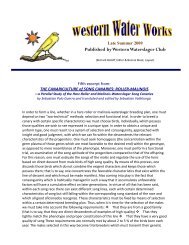Newsletter 1-06.pdf - Western Waterslager Club
Newsletter 1-06.pdf - Western Waterslager Club
Newsletter 1-06.pdf - Western Waterslager Club
Create successful ePaper yourself
Turn your PDF publications into a flip-book with our unique Google optimized e-Paper software.
I also value my hens at least as much and often more than my males. Ihonestly usually have a difficult time telling if the hen is actually the onecarrying a particular song but that is probably because my line is becoming moreconsistent so differences are subtle now. Sometimes it's obvious though as inwhen a new hen is introduced and the next generation offers a tour that I havenever heard in my bird room before.I also pay a lot of attention to the score sheet information of the ancestorsand sibs for my initial choosing, but a superior hen to me is one that has novices when raising her chicks (tossing, feather plucking, band chewing, etc.)and is a great feeder and is willing to foster any baby. Whenever possible,I try to check the band numbers to posted show results etc., I have found thatthe pedigrees themselves are a good place to start, but they are only asaccurate as the breeder's records and integrity. I also personally prefer thelarger birds so if the choice gets down to two sisters, I will usually choosethe larger.Darko KulicThis is my answer about hen line breeding in song canaries. If I can, I choose a hen whichis a sister of some good brothers. First, I keep only good mothers and normally theyshould have good young. I use each hen to the end of her life: only two rounds per year.Each hen is paired only with one male in a year. Only if I am testing new hens, then I willuse two males. This year was bad like a hurricane for hens. I had 20 hens for this season,but only 7 bred. Only 2 of my Belgian hens had young. Greetings from Croatia.HERE’S JOHNNY!By Richard RolloffRecently I attended the National Song Canary Show in Chicago, and was personallyhosted by “Johnny” Denan Denjo. I took the opportunity to interview him, anddocument his “system” of breeding/showing waterslagers.First you should know a little about Johnny. He was born, raised, and fought for what iscurrently Bosnia. He was shot three times, came home to his funeral, and spent 361 daysin a concentration camp. He emerged weighing 120 pounds. He is 6’2” tall and weighsslightly more than that now I mention this because it explains his sheer enthusiasm forlife, and in particular waterslagers.Johnny received his first bird at age 4. His father and uncle had canaries. His wholeculture spent several months each fall visiting and listening to each others birds. His“system” is quite simple, and he has often scolded me for making things too much work.“Canaries are seed eaters, why do you feed so much junk?” rings in my ears. It is his



